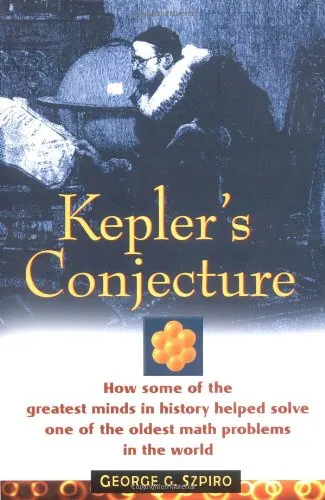Kepler's conjecture: how some of the greatest minds in history helped solve one of the oldest math problems in the world
4.4
Reviews from our users

You Can Ask your questions from this book's AI after Login
Each download or ask from book AI costs 2 points. To earn more free points, please visit the Points Guide Page and complete some valuable actions.Introduction to "Kepler's Conjecture: How Some of the Greatest Minds in History Helped Solve One of the Oldest Math Problems in the World"
For centuries, humankind's fascination with mathematics has driven inquiry into some of the most perplexing puzzles the universe conceals. Among these mysteries stands Kepler's conjecture, an enduring riddle in geometry proposed by the brilliant Johannes Kepler in 1611. It concerns the question of what is the most efficient way to pack spheres in space—a problem stemming from both academic curiosity and practical implications in fields ranging from logistics to crystallography. In my book, "Kepler's Conjecture," I trace the historical efforts to resolve this centuries-old challenge, showcasing the intellectual journeys that spanned generations and drew contributions from many of the greatest minds in mathematical history.
Detailed Summary of the Book
"Kepler's Conjecture" provides readers with an engaging narrative of how this problem unfolded across four centuries, culminating in a definitive solution. Johannes Kepler initially proposed that the best way to pack spheres is similar to the arrangement seen in a stack of oranges at a grocery store: the face-centered cubic lattice. While intuitive, proving this conjecture mathematically required leaps in logic, advances in computational tools, and interdisciplinary collaboration well beyond Kepler's era.
The book journeys through history—from Kepler’s original speculation, to Isaac Newton and David Gregory’s debates on the topic, to breakthroughs forged by Carl Friedrich Gauss. It also highlights the advent of modern computational mathematics, which played a pivotal role in its resolution through the groundbreaking work of Thomas Hales in the 1990s. Hales devised a computer-assisted proof so intricate that it spawned debate not only about mathematical rigor but also the evolving nature of proof itself in an increasingly digital age.
Blending storytelling with mathematical insights, I aim to illuminate the human element intrinsic to scientific discovery, revealing how creativity, perseverance, and collaboration drive progress in even the most abstract fields.
Key Takeaways
Reading "Kepler's Conjecture" offers insights into more than just the resolution of a mathematical question. Here are the key takeaways from the book:
- The importance of intuition in scientific inquiry and how it often precedes formal proof.
- How technological advancements such as computer-assisted proofs have transformed modern mathematics.
- The role collaboration plays in tackling seemingly insurmountable intellectual challenges.
- The interplay between pure mathematics and practical applications in fields like physics and material science.
- An appreciation for the historical development of ideas, offering perspectives on how academic disciplines evolve over centuries.
Famous Quotes from the Book
"In mathematics, assumptions are scaffolding; the beauty lies in proving what was once merely suspected."
"If spheres could speak, their compact arrangements would whisper the story of nature’s efficiency."
"In solving Kepler’s conjecture, humanity advanced not only its understanding of geometry but also its confidence in integrating human reasoning with machine precision."
Why This Book Matters
"Kepler's Conjecture" is far more than an exploration of a mathematical problem; it is a testament to human ingenuity and the lengths we go to uncover universal truths. Tackling this ancient puzzle bridges the gap between historical brilliance and modern computational skills, making it a cornerstone for those passionate about mathematics, history, and philosophy alike. Beyond its technical narrative, the book celebrates the relentless human drive for discovery, connecting past luminaries with contemporary genius and heralding the transformative power of collaboration.
Particularly in a time when computational tools are reshaping how we approach scientific problems, the resolution of Kepler’s conjecture serves as a perfect example of the partnership between humans and machines. It challenges traditional notions of proof and opens discourse on the future of mathematics itself. Whether you are a seasoned mathematician or someone who delights in intellectual history, this book holds relevance, offering perspectives that linger long after the final page.
Free Direct Download
You Can Download this book after Login
Accessing books through legal platforms and public libraries not only supports the rights of authors and publishers but also contributes to the sustainability of reading culture. Before downloading, please take a moment to consider these options.
Find this book on other platforms:
WorldCat helps you find books in libraries worldwide.
See ratings, reviews, and discussions on Goodreads.
Find and buy rare or used books on AbeBooks.
1109
بازدید4.4
امتیاز50
نظر98%
رضایتReviews:
4.4
Based on 0 users review
"کیفیت چاپ عالی بود، خیلی راضیام"


